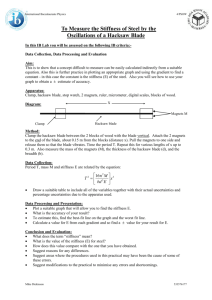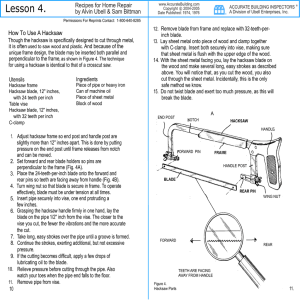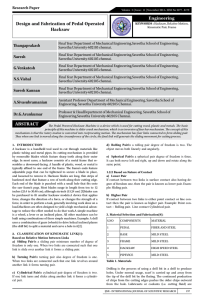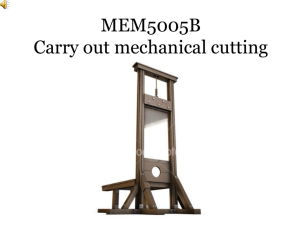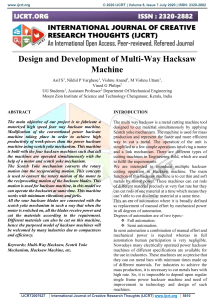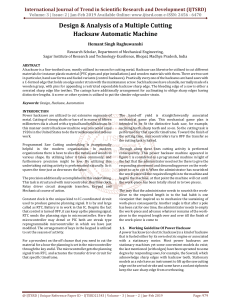rectification of power hacksaw machine
advertisement
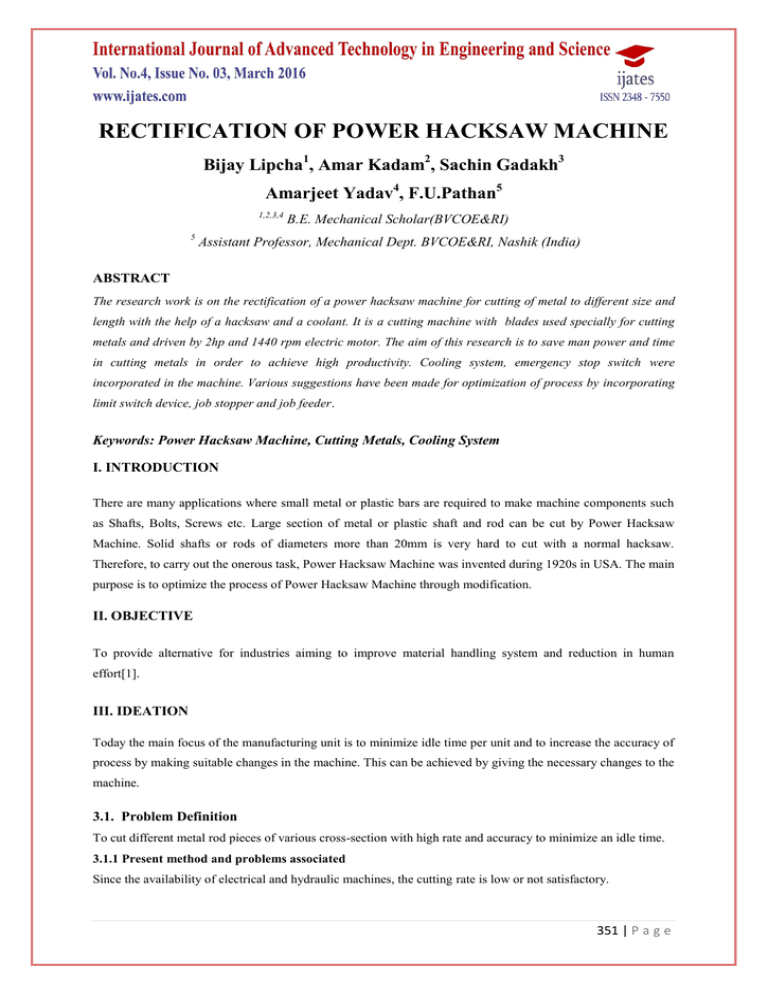
RECTIFICATION OF POWER HACKSAW MACHINE Bijay Lipcha1, Amar Kadam2, Sachin Gadakh3 Amarjeet Yadav4, F.U.Pathan5 1,2,3,4 5 B.E. Mechanical Scholar(BVCOE&RI) Assistant Professor, Mechanical Dept. BVCOE&RI, Nashik (India) ABSTRACT The research work is on the rectification of a power hacksaw machine for cutting of metal to different size and length with the help of a hacksaw and a coolant. It is a cutting machine with blades used specially for cutting metals and driven by 2hp and 1440 rpm electric motor. The aim of this research is to save man power and time in cutting metals in order to achieve high productivity. Cooling system, emergency stop switch were incorporated in the machine. Various suggestions have been made for optimization of process by incorporating limit switch device, job stopper and job feeder. Keywords: Power Hacksaw Machine, Cutting Metals, Cooling System I. INTRODUCTION There are many applications where small metal or plastic bars are required to make machine components such as Shafts, Bolts, Screws etc. Large section of metal or plastic shaft and rod can be cut by Power Hacksaw Machine. Solid shafts or rods of diameters more than 20mm is very hard to cut with a normal hacksaw. Therefore, to carry out the onerous task, Power Hacksaw Machine was invented during 1920s in USA. The main purpose is to optimize the process of Power Hacksaw Machine through modification. II. OBJECTIVE To provide alternative for industries aiming to improve material handling system and reduction in human effort[1]. III. IDEATION Today the main focus of the manufacturing unit is to minimize idle time per unit and to increase the accuracy of process by making suitable changes in the machine. This can be achieved by giving the necessary changes to the machine. 3.1. Problem Definition To cut different metal rod pieces of various cross-section with high rate and accuracy to minimize an idle time. 3.1.1 Present method and problems associated Since the availability of electrical and hydraulic machines, the cutting rate is low or not satisfactory. 351 | P a g e 3.2. List of components with materials[2],[3],[4] Following are the important parts of hacksaw machines: No. Components Material 1 Single phase electric motor - 2 Hacksaw Blade Bi-Metallic 3 Hacksaw Frame MS 4 Bearings High C-Cr steel 5 Material holding vise MS 6 Disc MS 7 Base MS 8 Universal joints Alloy Steel 9 Hacksaw Frame MS 10 Connecting rods MS IV.LITERATURE REVIEW The review of literature will help in understanding the concepts, theorems and different factors that affects the performance of machine. J.K.Gupta, R.S.Khurmi in their book “Theory of machines ” (Velocities in mechanisms) helps to find Velocity diagrams of slider crank mechanism[2]. Prof. Nitinchandra R. Patel, Ravi Thakkar, MiteshkumarRathwa stated that the appropriate saw blade must be selected for better operation and fine cutting by selecting number of teeth per inch in “Material selection and testing of hacksaw blade based on mechanical properties” which is his research paper[5]. There are four types of blades namely High Carbon steel, Alloy Steel, Bi-metallic strip and High speed steel blades[6]. Based on the properties of materials, Bimetallic blade is best suitable blade for cutting hard materials like Mild steel bar and Aluminium V.WORKING PRINCIPLE The power hacksaw's main feature is its reciprocating frame. The frame holds the hacksaw who’s main work is to reciprocate with its work of cutting material[7]. A large nut provides the amount of tension for holding the blade firmly in place. VI. PROCEDURE FOR SETUP AND OPERATION 1.Mount the work to be cut inside the vise 2.Lower the frame so that the blade is about 1/8" from touching the material 3.Using a scale, measure from the outer edge of the blade to the end of the work-piece 4.Tighten the vise 5.Recheck measurement 6.If multiple parts of the same size are to be cut, set the work stop to the desired length. 352 | P a g e (NOTE: In order to prevent damage to the blade, a gap must be provided between the stop and the workpiece). 7.Release the frame so that it rises to the start position. This will prevent the blade from contacting the material on the first stroke, which could damage the blade. 8.Select the proper speed and feed 9.Turn machine on 10.Engage power feed lever VII. THEORY Currently many electrically operated power hacksaw machines manufactured by different companies with different specifications are available for the use in shop floor. These machines are so designed that they can cut metal or plastic rods/bars with minimum time made up of different materials but they have one and major disadvantage that they can cut single piece of bar at a time. 7.1component[8] 7.1.1Frame The frame of hacksaw supports & carries the hack saw blade. The design of the machine is such that it allows the blade to contact the work-piece only on the cutting stroke. 7.1.2 Base The base of saw usually contain a coolant reservoir & a pump for conveying the coolant to the work. A table which supports the vise& the metal being is located on the top of base & is usually reffered to as the part of the base 7.1.3 Vise The vise is adjustable so that various size & shape of the workpiece may be held. On some machines the vise may be swivelled so that stock may be sawed at an angle. 7.1.4 Electrical AC motor The reciprocating motion of the blade is produced with the help of AC motor which operates by a simple crank mechanism. It is used for converts rotary motion into reciprocating motion. The AC motor is turned on after the work piece has been firmly fit in the chuck. The torque of motor is increased by the transmission of power to a pulley belt transmission. Fig 6.1.4 353 | P a g e 7.1.5 Hack Saw A hacksaw is a fine tooth saw with a blade under tension in a frame, used for a cutting materials such as metal or plastics. Hand-held hacksaws consist of metal frame with a handle & pins for attaching a narrow disposable blades. A screw or other mechanisms is used to put the thin blade under tension. Fig 6.1.6 A power hacksaw is a type of hacksaw that is powered by AC electric motor. Most power hacksaw are stationary machines but some portable model do exist. Saw blade is been lifted by the mechanism of stationary model and overheating of saw blade is prevented by coolant. 7.1.6 V- belt The belt are used to transmit the power from one shaft to another by means of pulleys. Which rotate at same speed or at different speeds. Fig 6.1.6 VIII. PRECAUTIONS Sawing machines have some special safety precautions that must be observed. Following are some safety precautions that must be followed: i. Keep hands away from the saw blade of the hack sawing machine or handsawing. ii. The blades must be handled carefully while its removal and installation. iii. Ensure the power supply is disconnected prior to removal or installation of saw blades 7.1 Don’t i. Do not use faulty equipment. Report suspect machinery immediately 354 | P a g e ii. Do not cut very small items iii. Do not cut metal other than metal. iv. Do not try to lift material that are too heavy for you v. Do not cut material of a shape that cannot be held firmly in the vice without taking precautions. vi. Never leave the machine unattended vii. Do not use compressed air for cleaning the machine. 7.2 Ending operation and cleaning up i. Switch off machine when work completed ii. Leave the machine and work area in a safe, clean and tidy state. IX. APPLICATIONS i. Cutting round/ square bars, tubes and pipes ii. Large profiles and solid materials iii. Tool room and engineering workshops iv. Stainless steel cutting v. Copper and alloy cutting vi. Engineering Industry vii. Construction Industry X.CONCLUSION At the end we conclude that the conventional Power Hacksaw Machine have low efficiency, low accuracy and takes more time per unit. So by doing necessary changes and incorporaing devices like limit switch, feeder and stoppers will increase efficiency and idle time per unit. REFERENCES [1] www.slideshare.net [2] R.S.Khurmi, J.K.Guptal, (2012)”Theory of machines”, Page no. 143-168 [3] PSG College of Technology, (2007) “Design Data Book”, Page no. 1.4-1.37 [4] V.B.Bhandari, Design of machine elements, Year 2007, Page no. 5-7 & 20-39 [5] Prof. Nitinchandra R. Patel, Mohammad A. Vasanwala, Balkrushna B. Jani, Ravi Thakkar, Miteshkumar D. Rathwa, ”Material selection and testing of hacksaw blade based on mechanical properties”,International Journal of Innovative Research in Science, Engineering and Technology, ISSN: 2319-8753, volume 2, Issue 6, June 2013. [6] Micro, Small and Medium Enterprises Development Institute,”Project profile on hacksaw blade manufacturing”, NIC code: 28939, ASICC code: 71303, 2010-11. 355 | P a g e [7] D.V.Sabarinanda, V.Siddhartha, B. SushilKrishnana, T.Mohanraj , “Design and Fabrication ofAutomated Hacksaw Machine”, International Journal of InnovativeResearch in Science, Engineering and Technology, ISSN (Online): 2319-8753, volume 3, April 2014 [8] Bradford Dittmer,” Build a power hacksaw from washing machine parts”. 356 | P a g e
